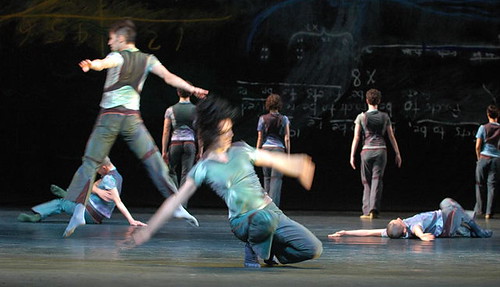Because it is a three-dimensional art, dance functions on at least two planes: one vertical, where the axis is the dancer’s spine (singular or plural), the other horizontal, the stage itself a two- (or more) dimensional canvas. Anyone who can remember footage of Busby Berkeley extravaganzas, or even the June Taylor Dancers of the 1950s, will recognize that there are forms of dance where a seat in the middle of the main level of a theater is a disadvantage. Another artist who makes great use of the horizontal as well as vertical plane is Shen Wei, the MacArthur-winning choreographer behind Shen Wei Dance Arts. Born in the province of Hunan & trained in calligraphy, painting and Chinese opera before helping to found the first modern dance company in China & then moving to the US in 1995, Shen Wei – he always uses both names – is a polymath & showman of the first order: his images & work will help to open & close the Olympics later this year in Beijing.
Considering the show his dance company performed a little over a week ago in the Perelman Theater of the
The most obvious one is that Shen Wei isn’t dancing with his troupe, but he does just about everything else, from sets to costumes to make-up. The first of his two pieces at the Kimmel was Map, a seven-part construction to excerpts from Steve Reich’s The Desert Music. Choreography to Reich’s music is so 1980s & Reich’s glaring misreading of William Carlos Williams’ poem of depression & despair is itself an odd choice for a work that seeks “to create an abstract dance of raw and pure movement.” But Shen Wei has no apparent interest in the work’s underlying text, so much as in the work’s construction into a symmetry of seven movements, rather on the order of a palindrome: ABCDCBA. Shen Wei uses each section to create a work that often is defined mathematically, using four groups of dancers for the most part in threes. The photo at the top of this note shows one moment of the work in which three groups are onstage simultaneously, involved in coordinated but separate activities. From up high – second balcony, first row – this is even more effective than viewed head on. Shen Wei’s experience as a painter comes across more powerfully here than in the I-wish-I-was-Robert-Rauschenberg-or-Jasper-Johns backdrop that is the set for this work.
There are some extraordinary moments in Map, starting with the beginning when the dancers snaking across the floor at the start of the opening section. The most extraordinary is the opening of the fifth section, and it’s worth quoting from the program, penned by Thea Little when the work was first performed in 2005:
In this section, the first dancer feels the internal flow of her center, leading her to eventually move to places of suspension and momentum. As she continues this for most of the section, a group forms to repeat an adagio phrase that is based on lengthening the space between the joints. The movement comes from the joints, as the shoulder, elbow, and wrist joints spread apart and lengthen to the fingertips. Thus, the limbs are lengthened as they swing from position to position with no effort. The movements are nonmuscular, with a floating internal quality. Soon, one by one, the dancers peel off from the group and dance their own solos until they are off stage.
The very opening portion, with the first dancer solo on the stage, her back turned to the audience, sort of wriggling up from her spine as she extends further & further, is flat out one of the most erotic moments I’ve ever seen in dance – even in blue jeans & a perfectly modest halter top.
In later sections, there are movements in which the dancers appear to mime the course of fireworks in the sky, or schools of fish darting about a tank. One can watch almost perfectly relaxed as the mind constantly rehearses the mathematical ratios as they play out on the stage.
The second, and much shorter, piece was Re- (Part I), “broadly based on the feeling of the land, the people, the religion and the culture of
So read the messages: modernism, Tai Chi, sand painting, abstract expressionism, Tibetan music – it’s almost a perfect pastiche of globalization in dance. As a whole, it proved more cohesive than Map, tho it did so by sacrificing some of the high points of the first work. My wife, who studied dance at the
What to make of all this? Should I be happy that so much of what I’ve enjoyed elsewhere over the past 30 or so years is connecting now with larger audiences in a slick motif? You don’t get a larger audience than the Olympic opening & closing ceremonies. Or should the constant appropriation of everything creep me out? There is, in fact, some first rate dance here, and some moments of first-rate choreography. But what I really saw & heard at the Kimmel was the cool construction of terrific theater, and a glimpse into the process by which what was once avant-garde becomes source material for pure pop.






